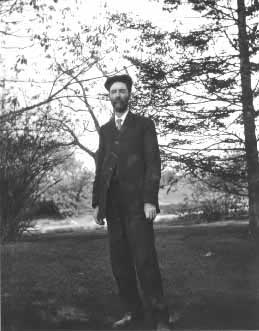

Title: Dr. Charles Edward Saunders - Dominion Cerealist at the Experimental Farm
Place: Ottawa, Ont.
Date: ca. 1910
PHOTOGRAPHER: Unknown
National Archives of Canada, negative no. PA-146055
Newfoundland's entry into Confederation in April 1949 presented an opportunity for the expansion of the services of the federal Department of Agriculture. As suggested in Record Group 17 (Agriculture Canada), one of the most significant results of this expansion was the establishment of the Newfoundland Experimental Station near St. John's. The federal experimental farms system was launched in 1886. John Carling, Minister of Agriculture from 1885 to 1892, and William Saunders, first director of the Experimental Farms Service (as it was known in 1886), channelled its activities towards experimentation and research in areas where Canada's principal farming problems existed. The system's first five facilities (the Central Experimental Farm near Ottawa for Ontario and Quebec, and satellite farms in Nova Scotia, Manitoba, Saskatchewan and British Columbia) were in place by 1890. By the early 1940s, there were 28 branch farms and stations, 24 sub-stations, and 10 branch laboratories. Formal discussions between Canada and Newfoundland concerning Confederation began in 1946. Dr. E.H. Barton, Deputy Minister of the Department of Agriculture, presented a scheme for the integration of federal agricultural services with those offered by Newfoundland's agricultural programs. Barton proposed the establishment of an experimental farm station in Newfoundland's as the focus of federal agricultural activity in the province. The St. John's farm, whose sole involvement with agricultural research had been a cooperative effort with the Nappan Experimental Farm in Nova Scotia to conduct plant variety trials and fertilizer tests in 1942, was chosen. Despite enthusiastic reports written by federal agriculture officials in 1946 about the suitability of the St. John' farm as an experimental farm site, the first proposal to renovate it with research facilities, rather than with farmer training facilities, was not supported by Newfoundland's government or residents. So frustrated was the Minister of Agriculture with Newfoundland's resistance to an experimental farm that the federal government secretly discussed a plan to buy the farm outright for $58,000, engage new staff, and establish an experimental facility without the blessing of the Newfoundland government. Both parties agreed to transfer the farm property free of charge, but Newfoundland officials felt the province should be compensated for the operating loss on the farm for the fiscal year 1949-1950, because the negotiations had dragged on for more than a year after other federal services want into effect. Finally, on March 31, 1950, the transfer of the Newfoundland Demonstration Farm to the Experimental Farms Service for the sum of $58,790 was achieved. This amount included the cost of buildings, stock and equipment, and the reimbursement of the provincial government. After four years of negotiations, the Experimental Farms Service officially initiated agricultural experimentation and research work in Newfoundland.
Victoria Blinkhorn
Government Archives Division